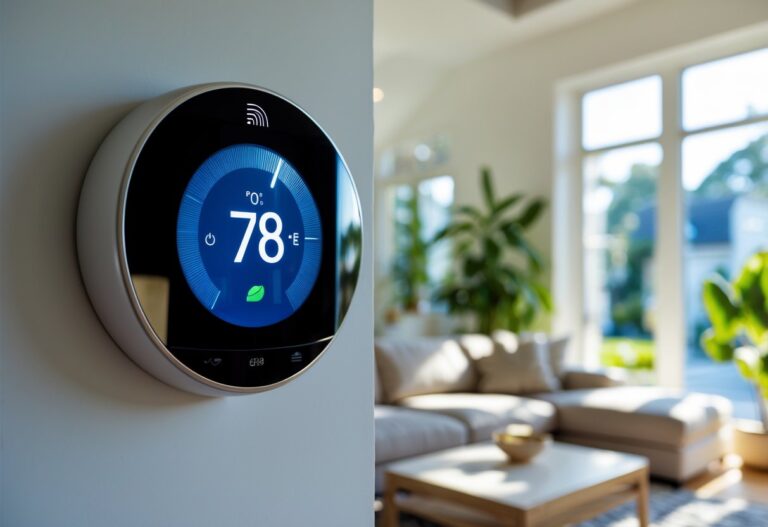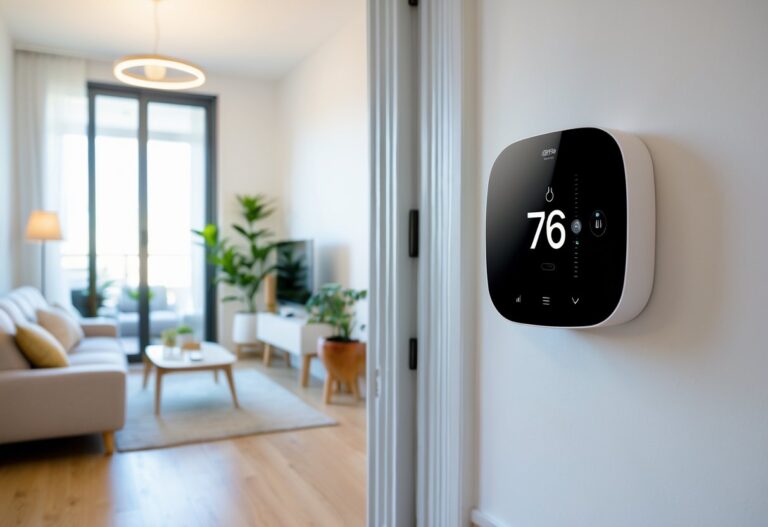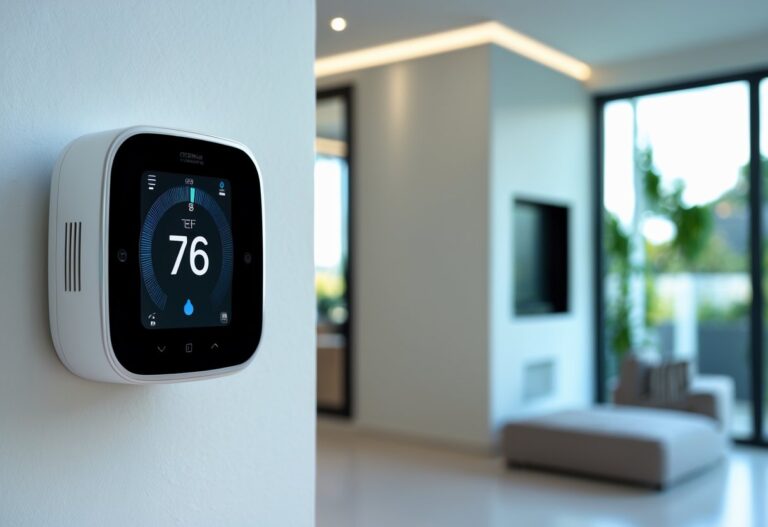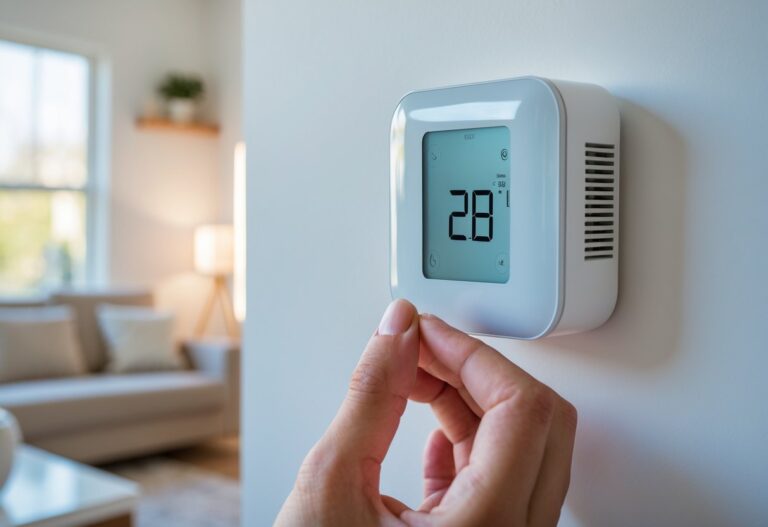Choosing a smart thermostat can make your home more comfortable and efficient, but finding one that works with Apple devices can be confusing. If you want to control your home’s temperature using your iPhone, iPad, or even your voice with Siri, it’s important to pick a model that’s fully compatible.

Many top smart thermostats easily connect with Apple HomeKit, including brands like Ecobee, Honeywell, and Netatmo. With these options, you can adjust your heating and cooling right from your Apple Home app or set up automations that fit your lifestyle. This guide will help you see which smart thermostats are the best match for your Apple setup and what features might matter most to you.
Key Takeaways
- Apple users have several smart thermostat choices that work with HomeKit.
- Compatibility and smart features can make home control simpler.
- Installation and energy savings are also important factors.
Understanding Smart Thermostats Compatible with Apple
Smart thermostats that work with Apple HomeKit let you control your home’s temperature using your iPhone, iPad, or Siri. These devices give you greater command over your home’s climate, while also improving convenience and security.
What Makes a Thermostat Apple-Compatible
For a thermostat to be Apple-compatible, it must support the HomeKit platform. This means the smart thermostat can connect with the Apple Home app and respond to commands from iOS devices.
Many HomeKit thermostats, like ecobee, Tado, and Nest (recently supported), include a special pairing code. You enter this code into your Home app to set up a secure connection. Once connected, you can control your thermostat with Siri voice commands or directly from your Apple devices.
HomeKit compatibility ensures that your thermostat uses Apple’s security protocols. It also means updates to your Apple devices will keep your thermostat running reliably.
Benefits of Using HomeKit Thermostats
Using a HomeKit-compatible thermostat lets you control your home’s climate from anywhere using your iPhone, iPad, Apple Watch, or even Mac. You can set schedules, adjust the temperature by voice, or use geofencing so your home adjusts the climate when you arrive or leave.
Some models can detect if a window is open and reduce energy use automatically. You get clear reports on energy consumption, which can help you save money over time. Alerts can notify you if there’s an unexpected temperature change in your home.
Automation is another strong feature. For example, you can set your thermostat to turn down when your security system is armed at night. These actions can all be managed from one place: the Apple Home app.
How Apple Home App Integrates with Smart Home Devices
The Apple Home app lets you manage HomeKit thermostats alongside other smart home devices like lights, cameras, and locks. All devices can be grouped by room, so you can control the temperature in specific areas.
You can create “Scenes” such as “Good Morning” or “Bedtime” that adjust the thermostat and other devices at once. The app works across your Apple devices, so changes made in one place show up everywhere.
Siri integration adds another layer of convenience. You can just say, “Hey Siri, set the living room to 72 degrees,” and it happens automatically. Firmware updates and settings are also managed within the Home app for a smooth experience.
Top Smart Thermostats That Work with Apple
Smart thermostats let you control your home’s temperature from your iPhone, iPad, Mac, or Apple Watch using Apple HomeKit. They can offer features like Siri voice control, remote access, and better integration with other smart home devices.
ecobee Smart Thermostat Family
ecobee offers several HomeKit-compatible thermostats. Models like the ecobee SmartThermostat with voice control, ecobee Smart Thermostat Premium, and ecobee3 Lite are popular choices.
You can control the temperature, set schedules, and check the current status through Apple’s Home app or with Siri. Most ecobee models also let you manage the temperature from anywhere using your Apple devices.
Features include built-in voice assistants (Alexa and Siri support), energy reports, and support for room sensors. These sensors help balance the temperature in different rooms, which can help save energy and keep your home more comfortable. Installation is simple for most homeowners, and ecobee thermostats often receive high marks for both reliability and HomeKit integration.
Common ecobee models compatible with Apple:
- ecobee SmartThermostat with voice control
- ecobee Smart Thermostat Premium
- ecobee3 Lite
Honeywell Home Models
Honeywell Home makes several thermostats that work with Apple HomeKit. The Honeywell Home T9 Smart Thermostat is a standout option.
The T9 model supports remote sensors you can place in different rooms. This lets you heat or cool the rooms that matter most, and you can see temperatures in each sensor’s location within the Home app. The Honeywell Lyric T6 Pro is also compatible and offers basic HomeKit support.
Honeywell’s thermostats connect to Apple’s Home app for easy control and automation. You can create schedules, use Siri to change the temperature, and connect your thermostat to other smart devices in your home.
Honeywell models are known for being reliable and easy to use. They usually require a C-wire for installation, so check your current setup before buying.
Popular Honeywell Home models with Apple compatibility:
- Honeywell Home T9 Smart Thermostat
- Honeywell Lyric T6 Pro
Emerson Sensi Touch Options
Emerson Sensi Touch is another trusted option for HomeKit users. The Sensi Touch Smart Thermostat works well with Apple’s Home app and supports remote access, scheduling, and automation.
You can use Siri voice commands to adjust the temperature or check current settings. The thermostat has a responsive touchscreen that is easy to read and simple to use. It also provides energy usage reports, which can help you save money over time.
Installation is straightforward, and Sensi provides an app with step-by-step guidance. The Sensi Touch’s compatibility with Apple HomeKit makes it a good choice for larger or older homes needing a modern upgrade.
Emerson Sensi HomeKit-compatible options:
- Sensi Touch Smart Thermostat
Other HomeKit-Compatible Brands
Besides the major brands, some other companies offer thermostats that work with Apple HomeKit. The iDevices Wi-Fi Smart Thermostat provides basic HomeKit support and fits most standard wiring.
The Kono KN-S-AMZ-004 by Lux is another option, with simple scheduling and Apple Home app integration. While Nest (Google) thermostats no longer offer direct HomeKit support, brands like Tado provide advanced smart features and seamless HomeKit compatibility.
When choosing any of these, check wiring requirements and look for official HomeKit support. Many offer similar core features, such as remote control, basic scheduling, and Apple Home app control, though options and designs may differ.
Key Features and Smart Home Integration
Smart thermostats that support Apple HomeKit give you more control over your home’s comfort and energy use. You can manage devices using your voice, set automated schedules, and adjust settings from anywhere.
Voice Control: Siri and More
With Apple HomeKit, you can use Siri voice commands to change the temperature or switch between heating and cooling modes. Siri integration lets you use simple phrases like “Hey Siri, set the hallway to 70 degrees” from your iPhone, iPad, Apple Watch, or even HomePod.
Many smart thermostats also work with other platforms such as Amazon Alexa, Google Assistant, and sometimes Samsung SmartThings. This means you can control your thermostat using different voice assistants, making it easy to fit into your existing smart home ecosystem.
Some thermostats also support Matter, a new smart home standard. Matter aims to make devices work across different brands and platforms, giving you more flexibility with voice controls and automation.
Scheduling, Automation, and Geofencing
Most HomeKit-compatible thermostats offer detailed scheduling features. You can set daily or weekly routines to match your lifestyle, like lowering the temperature at night or warming the house before you wake up. This can help save energy and make your home more comfortable.
Automation works with other smart home devices. For example, you can connect your thermostat with smart plugs or switches, so several devices respond together when you arrive home. Automation allows for scenes such as “Good Morning” or “Away,” where your thermostat works with other devices based on set conditions.
Geofencing uses your phone’s location to adjust settings automatically. When you leave home, the thermostat switches to energy-saving mode. When you come back, it restores your preferred temperature. This feature relies on Wi-Fi connectivity and is easy to set up using the Home app.
Remote Access and Unified Control
You can control your thermostat from anywhere using your iPhone, iPad, or Mac. Through the Apple Home app, you get remote access to settings, schedules, and temperature adjustments as long as your device has an internet connection.
Remote control is secure and can offer notifications, so you know when the temperature changes or when something needs attention. HomeKit also lets you have unified control over multiple smart home devices. This allows you to manage lighting, security, and climate from a single platform.
Many thermostats work with other systems like IFTTT or SmartThings, making it easier to control different brands together. Wi-Fi connectivity is required for most remote features, making setup straightforward if your home has stable internet.
Installation, Compatibility, and Energy Efficiency
When choosing a smart thermostat that works with Apple HomeKit, it’s important to check how it fits with your current HVAC system and whether the setup matches your skill level. Comparing energy-saving features and understanding how temperature control works can help you decide what device is best for your home.
Thermostat Compatibility and C-Wire Requirements
Smart thermostats are not one-size-fits-all. Before you buy, review the compatibility list for each device and make sure your HVAC system type, like central air or heat pump, is supported.
Most smart thermostats, such as those from Ecobee, Honeywell, and Emerson, need a dedicated C-wire for consistent power. If your system doesn’t have a C-wire, some thermostats include a power adapter or offer workarounds, but this can add extra steps.
Always check the manufacturer’s website for a compatibility checker. If you’re not sure about your setup, talking to an HVAC professional can help you avoid installation problems.
Easy Setup Process and Professional Installation
Many smart thermostats are designed for simple installation. Most models include color-coded wiring terminals, step-by-step smartphone guides, and easy-to-follow instructions.
Typical installation takes 30 to 60 minutes if your system already has a compatible C-wire. If your wiring is older or less common, or if a C-wire adapter is needed, the process may take longer.
If the instructions seem overwhelming or you’re not comfortable with electrical work, hiring a professional is a safe choice. Professional installers can handle complex wiring and make sure your system and thermostat work together as expected.
Energy Savings and Efficiency
Smart thermostats made for HomeKit, like the Ecobee and Honeywell T9, offer energy-saving features such as scheduling and occupancy sensing. You can set different temperature ranges for various times of day, helping reduce wasted energy.
Features like remote temperature sensors and geofencing adjust heating or cooling when you are away. Some models provide energy reports and tips, so you can track your usage and savings.
According to manufacturers, users can save between 10% to 23% on heating and cooling bills, depending on personal habits and home size. Automation settings available through the Apple Home app can further improve efficiency.
Temperature Control for HVAC Systems
A HomeKit-compatible smart thermostat gives you precise control over your home’s temperature using your iPhone, iPad, or voice commands with Siri. Most models support both single-stage and multi-stage systems.
Some come with extra remote sensors (like Ecobee SmartSensor) that let you monitor and manage temperature in more than one room. This helps reduce hot or cold spots and keeps the whole house comfortable.
With HomeKit, you can also connect the thermostat to other smart devices such as fans, air purifiers, or window sensors. This allows for automatic adjustments based on conditions like open windows or outdoor temperatures, making your system more responsive.





